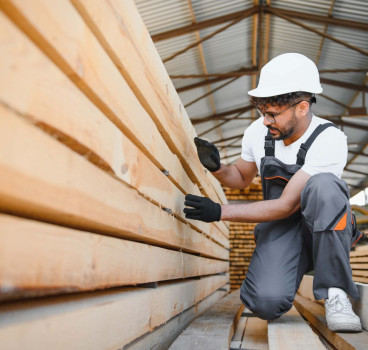Cool roofs and why they will continue to grow
Hotter summers are helping to create uncomfortable living and working environments in towns and cities across the globe. Extreme heat events are becoming more frequent due to climate change – and these in turn are leading to additional challenges for the roofing industry. Thankfully, there is a simple yet powerful solution – cool roofs. The concept has been around in various forms for many years – but it is continuing to gain traction across the world, writes John Ridgeway.
Cool roofs are designed to reflect a significant portion of solar radiation and absorb less heat compared to traditional dark roofs. This translates to cooler buildings that require less energy for air conditioning. Typically made with reflective materials like light-coloured metal panels, special coatings applied to existing roofs, or specialised tiles, cool roofs can significantly impact a building's energy consumption and overall thermal performance.
By reflecting sunlight away from urban areas, cool roofs can help mitigate the urban heat island effect. This phenomenon occurs when cities with a high density of buildings and pavements absorb and re-radiate heat, leading to higher ambient temperatures compared to surrounding rural areas. Cool roofs can help lessen the urban heat island effect, contributing to a more comfortable living environment for city dwellers.
That said, the concept of cool roofs is not entirely new. Traditional building practices in hot and sunny regions often incorporate elements designed to keep buildings cooler. Light-coloured roofs made from materials such as clay tiles, limestone, or whitewashed surfaces have been employed for centuries in the Mediterranean and Middle Eastern regions.
However, the development of modern cool roof technology with scientifically engineered reflective coatings is a more recent phenomenon. The pioneering work began in the mid-20th century, driven by a growing awareness of energy efficiency and concerns about rising energy costs.
Reflective coatings
Modern cool roofs achieve their reflectivity through a variety of coatings applied to the roof surface, such as high-reflectance paints. These white or light-coloured paints offer a cost-effective option for cool roofs. They typically use pigments like titanium dioxide to reflect solar radiation.

Pre-painted metal roofs with high solar reflectance properties are a popular choice for commercial buildings. These coatings are often formulated with metallic pigments or ceramic granules. Sprayed elastomeric coatings also provide waterproofing benefits along with high reflectivity. They are often sprayed onto existing roofs for cool roof refurbishment projects. In addition, reflective films can offer exceptional solar reflectance but may require specialised installation techniques.
The effectiveness of a cool roof coating is measured by its solar reflectance index (SRI) and thermal emittance (e-mittance). SRI measures a material's ability to reflect sunlight and solar heat. Emittance indicates how effectively a material releases absorbed heat back into the atmosphere. Cool roof coatings are designed to have high SRI and high emittance for optimal performance.
Changing regulations
The growing popularity of cool roofs, particularly in North America, is driven by a wide range of different factors. Stricter energy efficiency regulations are mandating the use of cool roofs for new construction or major renovations. For example, California's Title 24, Part 6, the state's building energy efficiency standards, requires cool roofs for most low-pitch commercial buildings. Similar regulations are in place in other regions like Florida, Texas and Arizona, all areas prone to high heat and energy consumption.
As energy costs steadily rise, cool roofs offer a compelling solution for building owners seeking to reduce costs. Studies by the U.S. Department of Energy (DOE) show that cool roofs can reduce a building's cooling energy consumption by 10-30%, translating to significant savings. A 2016 report by the Lawrence Berkeley National Laboratory found that cool roofs in California alone could save building owners $1.8 billion annually in energy costs.
Some European countries are also implementing regulations and offering incentives to promote cool roofs. For instance, France has mandated cool roofs for new commercial buildings in some regions and Italy is offering tax breaks for building owners who instal this technology.
Like the US, European cities are also facing challenges with rising temperatures. Cities like Milan and Athens are implementing initiatives to promote cool roofs in an effort to mitigate the urban heat island effect. The headquarters of the European Commission in Brussels features a cool roof and the city of Rotterdam in the Netherlands has a programme to promote cool roofs for residential buildings.
In Asia, rapid urbanisation and economic growth are a driving a focus on energy efficiency in buildings. Cool roofs are seen as a viable solution for reducing cooling energy consumption.
Independently, countries like China and India are introducing initiatives that promote cool roofs. China has even established cool roof rating systems and demonstration projects to encourage their adoption.
Australia's hot and sunny climate makes cool roofs a natural fit. Regulations and incentives in some regions encourage cool roof adoption as a way to reduce a building's environmental impact.
More than a cool roof
Cool roofs are no longer a niche concept and are being introduced on to a wide range of different building types. In North America large commercial buildings with extensive roof areas, are benefitting. The Empire State Building in New York City is a prime example. In 2010, the iconic skyscraper underwent a major renovation that included installing a cool roof membrane, to reduce energy consumption and lessen the urban heat island effect. Similarly, Walmart, a major retailer known for its sustainability efforts, has incorporated cool roofs into the design of many of its stores across the country.
Cool roofs are becoming increasingly popular for residential buildings as well. Homeowners in hot climates are recognising the benefits of cooler homes and lower energy bills. Several roofing manufacturers offer cool roof shingles and coatings specifically designed for residential applications. These solutions are often aesthetically pleasing and can complement various architectural styles.
Designing a cool roof
While the benefits of cool roofs are clear, they are understandably at their most effective in hot and sunny climates. In colder regions, the benefits of reduced cooling energy consumption may be offset by increased heating costs.
Not all roof types are suitable for cool roofs. Flat roofs or low-pitch roofs offer the most significant area for reflecting sunlight. The structural integrity of the roof should also be assessed to ensure it can handle the weight of additional materials.
Material selection also has to be considered. Different cool roof materials offer varying levels of solar reflectance and thermal emittance (ability to release absorbed heat). Regular maintenance is also crucial for maintaining the effectiveness of cool roofs. Dirt and debris buildup on the reflective surface can reduce its performance.
The role of good insulation
Some of you reading this blog might well be wondering right now about the role insulation plays in terms of reducing heat transfer. We all know that good insulation acts as a barrier, slowing the transfer of heat (both radiant and conductive) between the interior and exterior of the building. This helps keep the building cooler in summer and warmer in winter – so why the need for a reflective coating?
It's a good question and the ideal solution for keeping a building cool often involves both cool roofs and insulation working together. Cool roofs address the heat gain from sunlight, while insulation prevents heat transfer through the roof itself. This combined approach can lead to significant energy savings, improved comfort and a reduced environmental impact.
The future of cool roofs
It is another reason why the cool roof market is projected to experience significant growth. As the demand for cool roofs increases, exciting advancements in materials and technologies are emerging, further improving their performance and appeal.
Advanced reflective coatings are constantly being developed to offer even higher solar reflectance and lower thermal emittance. These coatings can be applied to existing roofs, making cool roof adoption more accessible. Nanotechnology is also being explored to create cool roof materials with self-cleaning properties, reducing maintenance needs
As sustainability is a key focus in the construction industry, researchers are also developing cool roofs made from bio-based materials like recycled content or even plant-based materials. These solutions offer a lower environmental footprint compared to traditional cool roof materials.
Furthermore, cool roofs when combined with solar panels can be a powerful combination for sustainable buildings. Reflective surfaces beneath solar panels can help them operate more efficiently by reducing heat buildup. Research is ongoing into integrating cool roof materials directly into solar panels, creating a single, multifunctional roof system.
Cool roofs are a simple yet powerful technology with the potential to significantly improve energy efficiency, mitigate the urban heat island effect, and create a more sustainable future.
As regulations become stricter, energy costs rise, and the focus on heat mitigation intensifies, cool roofs are poised to become the standard for new construction and renovations. With ongoing advancements in materials and technologies, coupled with effective collaboration among stakeholders, cool roofs can play a vital role in shaping a more sustainable and resilient built environment – time will tell.
Sources:
Lawrence Berkeley National Laboratory: “Economic Benefits of Cool Roofs in California” (https://buildings.lbl.gov/cool-roofs-walls)
- U.S. Department of Energy: Cool Roofs (https://www.energy.gov/energysaver/articles/energy-101-video-cool-roofs-1)
- Cool Roof Rating Council: (https://coolroofs.org/)
- Environmental Protection Agency: Using Cool Roofs to Reduce Heat Islands (https://www.epa.gov/heatislands/using-cool-roofs-reduce-heat-islands)
Additional Blogs

What if Building Control went fully digital?
Building control governs structural integrity, fire protection, energy efficiency, accessibility and countless other aspects of design and construction. Historically, this process has been highly...
Read moreWhere most “Smart Buildings” go wrong
Smart buildings are often presented as the ultimate in modern construction - interconnected, efficient, intuitive and driven by real-time data. They promise lower operating costs, reduced energy use,...
Read more

The future of facilities management starts at RIBA Stage 0
Facilities management has traditionally been treated as a discipline that only becomes relevant once a building is handed over. At that point, FM professionals inherit decisions made months or years...
Read more